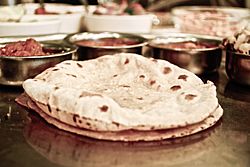Chapati facts for kids

Chapatis served with various side-dishes
|
|
| Alternative names | Roti, roshi, safati, shabaati, phulka, lavash |
|---|---|
| Type | Bread |
| Place of origin | Indian subcontinent |
| Region or state | Indian subcontinent, Central Asia, Southeast Asia, East Africa, United Kingdom, Arabian Peninsula, Caribbean, Armenia |
| Main ingredients | Wheat flour, water |
Chapati is a popular type of flatbread that comes from the Indian subcontinent. It's also known by names like roti, phulka, or chapo in different places. Chapati is a staple food, meaning it's eaten almost every day, in countries like India, Nepal, Pakistan, and parts of East Africa and the Caribbean.
Chapatis are made from a special whole-wheat flour called atta. This flour is mixed with water, and sometimes a little oil or salt, to make a soft dough. The dough is then flattened and cooked on a hot, flat pan called a tava. Unlike some breads, chapatis are unleavened, which means they don't use yeast or baking powder to rise.
People from the Indian subcontinent have shared chapatis with many other parts of the world. This includes places like Central Asia, Southeast Asia, East Africa, and the Caribbean islands.
Contents
Discovering Chapati's Past
Chapati is a type of roti, which simply means "bread." The words are often used to mean the same thing. The word chapat means "slap" or "flat." This describes how people traditionally shape the dough by slapping it between their wet hands. Each slap helps to make the dough round and thin.
Chapati is mentioned in old writings. For example, it appears in the 15th-century Guru Granth Sahib, a holy book. It was also noted in a 16th-century document called Ain-i-Akbari. This book was written by Abu'l-Fazl ibn Mubarak, who worked for the Mughal Emperor Akbar.
Wheat bread, like chapatis, has been a main food in the Indian subcontinent for a very long time. Scientists have found ancient wheat grains at places like Mohenjo-daro. These grains are similar to wheat still grown in India today. The Indus Valley region is known as one of the first places where wheat was grown.
How Chapatis Are Made
Chapatis are made from a simple dough. It uses wheat flour, salt, and water. The flour used for chapatis is ground more finely than most whole wheat flours you might find in Western countries.
Preparing the Dough
First, the flour, salt, and water are mixed together. Then, the dough is kneaded well. Kneading helps to make the dough soft and stretchy. After kneading, the dough is left to rest for about 10 to 15 minutes, or even up to an hour. This resting time helps the dough become softer and easier to work with.
Shaping and Cooking
Once the dough has rested, small pieces are pulled off. Each piece is rolled into a round ball. These balls are then flattened between your palms. Next, they are dipped in flour and rolled out on a special circular board called a chakla. A rolling pin, known as a velan or belan, is used to roll the dough into a thin, flat circle. There are even machines that can do all this automatically!
The flat dough is then placed on a hot, dry tava (a flat skillet). It cooks on both sides. In some parts of India, chapatis are only partly cooked on the tava. Then, they are put directly over a flame. This makes them puff up like a balloon! The hot steam inside cooks the chapati quickly. This puffed-up chapati is sometimes called a phulka.
After cooking, chapatis are often spread with butter or ghee (clarified butter). In some areas, a little oil is added inside the dough before it's rolled out. This makes it different from a paratha.
Sizes and Tools
The size and thickness of chapatis can be different depending on the region. Chapatis made at home are usually about 15 to 18 centimeters (6 to 7 inches) wide. This is because the tava fits comfortably on a home stove. Traditionally, tavas were made of clay, but now they are usually metal. The rolling pins also come in different shapes.
Different Types of Flatbreads
In the Indian subcontinent, people know the difference between a chapati and other flatbreads. These include roti, paratha, kulcha, puri, and naan. The differences come from how they are cooked, their texture, and the types of flour used. For example, parathas are often layered with ghee or filled with vegetables. They are usually made with all-purpose flour, not whole wheat flour.
Regional Chapati Varieties
India has many regional kinds of chapati:
- Paneer chapati: This has grated Paneer (Indian cheese) mixed into the dough. It's also known as 'paneer paratha'.
- Radish chapati: Grated radish and turmeric powder are added to the dough. This chapati is usually thicker. It's often called 'mooli paratha'.
- Vegetable-stuffed chapati: These chapatis are filled with mashed vegetables like carrot, potato, or peas, cooked in a spicy sauce. They are often served rolled up.
Aloo paratha is a very famous chapati from Northern India. It's stuffed with boiled potato and onions. People often eat it with pickle and curd (yogurt). In winter, you can also find Gobhi Paratha (stuffed with cauliflower) and Mooli Paratha (stuffed with radish).
In the Maldives, chapatis are a traditional breakfast food. They are eaten with a dish called mas huni.
Indian breads are both tasty and healthy. Chapatis are a great match for curries, dry vegetable dishes, chutneys, or dal (lentil soup).
Images for kids
See also
 In Spanish: Chapati para niños
In Spanish: Chapati para niños










